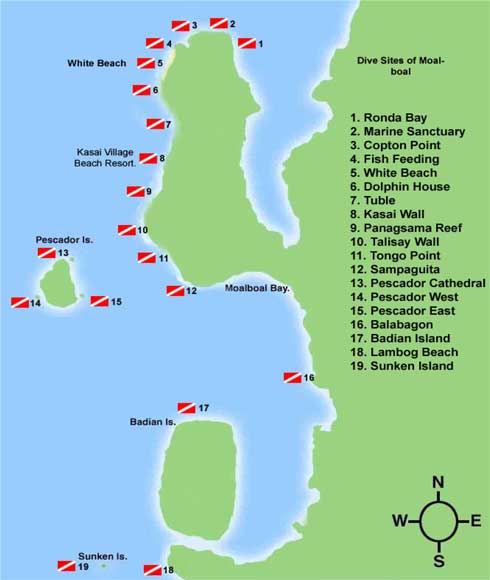Philippines Diving
Philippines Dive Regions
Philippines Diving
Visayas
Bohol
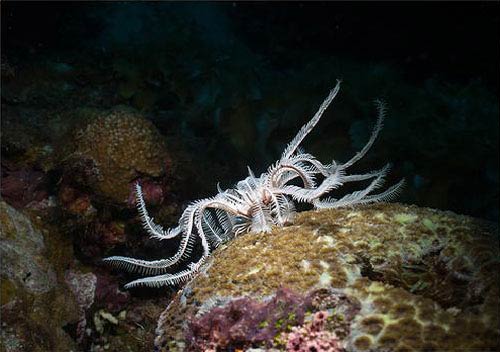
Bohol offers a number of top diving sites. The diving season is year-round. Expect some ...

Bohol offers a number of top diving sites. The diving season is year-round. Expect some monsoon rains between July and September. But it is generally too far south to be affected by the rainy season typhoons.
Cabilao Island
This eight-square-kilometer island jutting out into the waters of the Cebu Strait and the Bohol Sea is the convergence point of hammerheads sharks, tunas, dolphins, groupers, and mackerel that abound around the island. Chartered dive boats running from Mactan Island on Cebu down Balicasag often include a stopover at Cabilao Island on their itineraries. This spot is just off the west coast of Bohol, about 2 hours out of Mactan (in fair weather) and 2 hours from Balicasag. Shark sightings are generally rare in the Philippines - presumably due to fishing pressures - but this site is sometimes patrolled by schools of hamerheads.
Sightings are common shortly after sunrise or just before sunset. The best dive is on the edge of a sand-flat which projects westward from the point at the northwest tip of the island. Go down 30-35 meters(90-105 feet) and work your way along th e wall (it drops off to considerable depth). In addition to the sharks, you may see large barracudas and game fish. Colonies of garden eels live in the sand-flat. When they poke their heads out of their hoels to feed, their upper bodies sway in the current like a living carpet of long grass. As you approach they'll withdraw quickly into the sand. Strong tidal currents run at up to 3 knots, which means you need a high level of experience, a knowledgeable guide and proper timing in order to guarantee an enjoyable diving experience here.
Black Coral Forest
The rare opportunity to swim through a "forest" of black coral makes this dive an experience not to be missed. Although this form of coral is usually found below 50 meters (150 feet), there's an area on the northern tip of the island where it grows at a surprisingly shallow 30 meters (90 feet). Biologists have speculated that the shadow of the island combined with the coolness and nutrients provided by currents and upwellings "deceive" the coral into thinking its at greater depth. The forest of bush-like coral has taken root on a portion of the reef whee ledges and rock faces are interspersed with patches of sloping sand.
The coral trees are set wide enough apart for you to be able to fin gently among them, altough you must take great care not to damage any of them. Apart from the black coral, you'll also see schools of tropical fish - such as morrfish idols, batfish and lionfish - along with assorted nudibranches, including Spanish dancers. It's best to time your dive here for a slack tide, or else make sure you have a boat ready to pick up if the currents are strong.
Turtle Point
This dive takes you down the drop-off on the eastern side of the island, and gets its name from the turtles which hide in caves about 20-25 meters (60-75 feet) down. The key word is "hide". Don't be surprised if turtles do not materialize immediately: be patient, and if you're lucky you'll soon see what one diver described as a "B-52 sized" turtle swim out of its lair. While you wait, you can enjoy the scenery on the wall outside the caves: cushion stars, a profusion of feather stars, and a vast variety of reef fish, including lionfish and triggerfish. Mackerel are also common. In the shallower water here anemones, always with their resident clownfish, are abundant.
Boracay
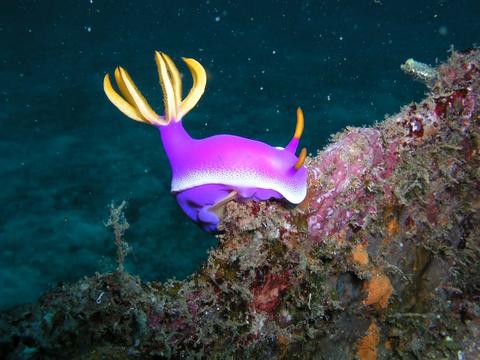 Famed for one of the finest white sand beaches in the world, the tiny island of Boracay, off the norther ...
Famed for one of the finest white sand beaches in the world, the tiny island of Boracay, off the norther ...
 Famed for one of the finest white sand beaches in the world, the tiny island of Boracay, off the norther tip of Panay, has become a beach lover's Mecca.
Famed for one of the finest white sand beaches in the world, the tiny island of Boracay, off the norther tip of Panay, has become a beach lover's Mecca.
It is also a popular dive spot and sports almost 20 dive schools offering the entire range of dive activities from basic demonstrations through to advanced level certifications. Boracay is a great dive holiday location, simply because it combines a wide range of dive activities with one of the best beaches in the world plus the numerous good quality resorts, restaurants, bars and night time events.
Protected from the strong easterly typhoons, Boracay can be found at the northwestern tip of Panay. It is made up of three local communities: Yapak, Balabag and Manoc-manoc.
Maniguin
Locally called Maningning or commonly known as Hammerhead Island. It is 48 kilometres Southwest of the main Island of Boracay.
Yapak
The most exciting dive in Boracay Island. This is a wall starting at 100ft/90m which is covered with big barrel sponges, starfish, soft corals, gorgonians, reef fish as well as pelagic. An ideal site for experienced and advanced divers.
Friday's Rock
It is a big boulder of rock rising from sand at 54ft/18m. Beside this huge rock, this site is where the dive operators conduct fish feeding
Village Reef (Carabao Island)
It is a rich coral garden on a gentle slope, which is followed by a drop-off descending to 72ft/24m.
Cathedral Cave (Carabao Island)
It is a big cave with a large entrance, which is safe for less experienced divers. At the back of the cave, there are cracks and fissures which are often seen
Black Rock
It offers good diving. Condition is often calm but it can really get rough at times. Visibility can reach to 75ft/25m.
Malapascua
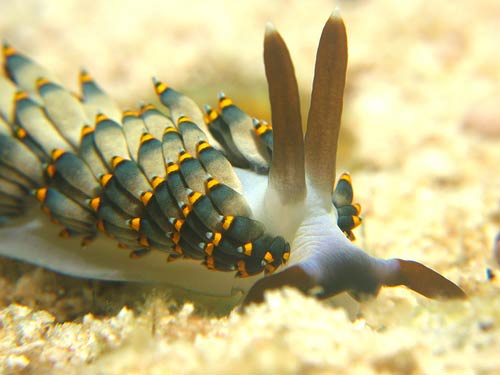
Malapascua Island has something for all divers, so come and dive the best kept secret ...

Malapascua Island has something for all divers, so come and dive the best kept secret of the Philippines - indeed of South East Asia. The Philippines is the new Thailand, but with much better diving and without the crowds! So make your next scuba diving trip to Malapascua!
Malapascua diving offers: the only daily thresher shark sightings in the world, whitetip sharks, mantas & hammerheads, wrecks , mandarin fish, countless nudibranchs, pygmy seahorses, cuttlefish, beautiful unspoiled coral gardens and a huge diversity of marine life.
Monad Shoal/Shark Point: 26m+ / 80ft+
Monad Shoal is an underwater island on the edge of a 200m drop off, and is famous as the only place in the world where thresher sharks can be seen everyday. The shoal attracts other pelagics such as devil rays and manta rays on a regular basis. Hammerheads can also be seen at certain times of the year. Monad Shoal is perfect for Nitrox. Find out more about Monad Shoal and its threshers.
Gato Island: 24m / 80ft
Gato Island is one of our most famous dive site. Gato is a marine reserve and sea snake sanctuary and has at least five dive sites with a huge diversity of marine life. We are constantly seeing new creatures. At all sites you can see such things as banded sea snakes, cuttlefish (often while mating), seahorses, nudibranchs, frogfish, moray eels, scorpion fish, squid and big-mouthed mackerel. There are many whitetip sharks in residence at Gato, as well as bamboo and cat sharks. The coral is in good condition and the rocky island has many interesting underwater rock formations and overhangs.
Gato - Whitetip Alley: 20m / 70ft
You are 95% guaranteed to find whitetip sharks sleeping under rocks, and if you are lucky you will see them circling. Other life here includes banded boxer shrimp, crinoid cuttlefish, seahorses and scorpionfish. A huge marble ray is currently in residence.
Gato - The Guardhouse: 24m / 80ft
Drop down to 24m to find the extremely rare pygmy seahorse, both pink and yellow. Then work your way back along a wall where you can find lionfish and many nudibranchs, including the beautiful spanish dancers, up to 30cm long.
Gato - Nudibranch City: 22m / 75ft
As the name implies, we find nudibranchs galore at this site. Also around are lots of hermit crabs and scorpion fish.
Gato - The Tunnel: 10m / 35ft
Journey underneath Gato Island and come out the other side! This large cave houses all the usual cave dwellers like crabs and lobsters. You should also encounter some large puffer fish. Most of exciting of all, the cave is home to whitetip sharks! You may see them hiding in a corner as you pass by inches from their face, or see their silhouette as they circle near the exit. If you are careful, you can sit in the cave and watch them circle. The sight is simply breathtaking. For experienced divers only.
Gato - Cathedral: 22m / 75ft
Explore some of the more amazing rock formations around Gato, including the stunning Cathedral rock. This is a great place to see sharks - we have seen as many as 15 whitetips circling. It is also possible to see blue-spotted rays.
Moalboal
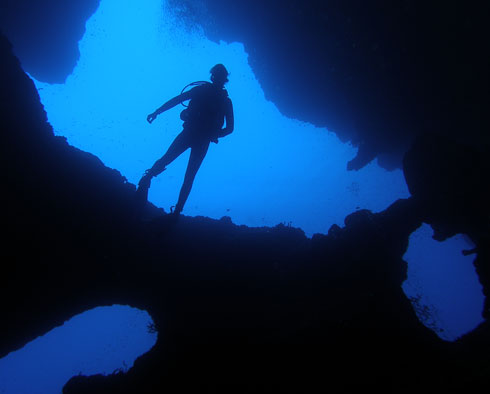
Moalboal's diving is renowned initially for frequent hammerhead shark sghtings around Pescador Island that are now far less common... ...

Moalboal's diving is renowned - initially for frequent hammerhead shark sghtings around Pescador Island that are now far less common... 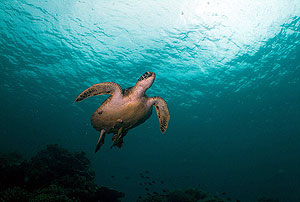 some say due to warming water temperatures driving them deeper, and other put down to fishing. The corals remain excellent in the area and the marine biodversity high, whilst the channel separating Cebu Island from Negros, easily visible from Moalboal, is an important migration path for whalesharks.
some say due to warming water temperatures driving them deeper, and other put down to fishing. The corals remain excellent in the area and the marine biodversity high, whilst the channel separating Cebu Island from Negros, easily visible from Moalboal, is an important migration path for whalesharks.
There are also several pods of dolphins resident close by.
Diving in Moalboal is year round, though the "high season" starts in mid October and continues through until May.
